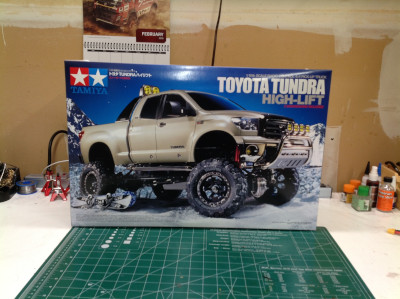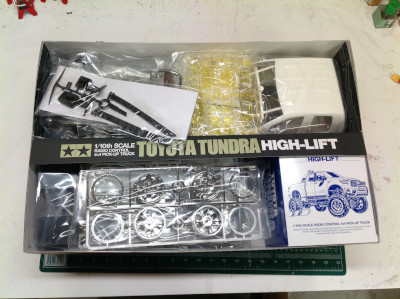Toyota Tundra Project
Page 1: Construction
I have previously built another truck in the Highlift series, the Ford F-350.
Since I already wrote about that build in detail and this build is
nearly the same, please check that page for more detail if
desired. This page will focus on the differences.
The Tundra comes in a huge box with a photograph rather than traditional
box art on the cover. The contents are carefully presented as per
usual for Tamiya, but without the extra bling of any blister
packs. The majority of the hardware and the motor are in the small
box on the bottom right.
I've arranged the parts needed for the chassis which are enough to fill
my build table. The parts for the body are in the box until I need
them. The main thing to note here are the metal chassis rails
which are actually different than the F-350. They include multiple
hole locations for the transmission and the leaf springs are a
different length.
The transmission is exactly the same as in the F-350, but I couldn't
resist taking some more pictures just because it is so cool. Gotta
love all those pretty gears. As usual, I did swap out all the
bushings for ball bearings. On the right you can see the motor and
transmission installed on the frame rails along with the cross members
and suspension mounts. The front bumper is also mounted directly
to the frame.
The front and rear axles are very similar to those on the F-350 but the
differential covers are different. They are chrome plated but I
painted transparent red over them to somewhat match the red anodized
shocks. The leaf springs are very hard but they tend to soften as
they break in over time. On the right the axles and shocks have
been installed completing the suspension.
Now I've installed the wheels and tires. The tires are the same as on
the F-350 but the wheels are different and include faux beadlock rings
which must be glued to the wheels. I painted them with trans red
like the diff covers and am happy with the look. I plan to install
the MFC, but at this point I've installed a temporary control system to
try the truck out. The battery access is a little different than
the F-350. It is still mounted under the chassis behind the
transmission, but because the body is mounted higher you don't need to
tilt the bed to access it. Instead the left hand running board can
pivot out of the way allow battery access. The running board is
held in place when stowed by a magnet. I've also installed the
front bull bar here along with the 4 fog lights.
The vast majority of the body is comprised of only two parts which makes
it very easy to set them on the chassis and get an idea of how this
truck is going to look when finished. The left hand image shows
the unpainted body parts. On the right, I've applied the champagne
gold paint, the stickers, and the clear coat. The grille is
sitting in place but not yet attached. All the details are yet to
be added.
There are only a handful of decals that are used per the instructions
and they include things like the Toyota logo on the grille and some
markers. For these V8 side markers, a metal transfer is but over
the top of a sticker.
There are several optional ways to finish off the truck per the
instructions, and the optional parts are present in the box. One
option consists of 5 marker lights on the roof above the
windshield. You have to drill holes in the cab to put LEDs in
them, so once you decide to use this option there's no going back.
I like lots of lights, so I installed this option. There's also a
roof rack with a pair of snowboards as pictured on the left. It
was original plan to use this option because I think it really makes
this truck different than my others, but in the end I was not happy with
the colors on the snowboards and how they clashed with the tribal
decals on the body. I also didn't like that use of the roof rack
means you can't use the roll bar. I removed the rack and went with
the roll bar instead. It is worth noting that the side mirrors
are rubber which makes them resistant to rollover since they can bend
out of the way rather than breaking.
©2019 Eric Albrecht

